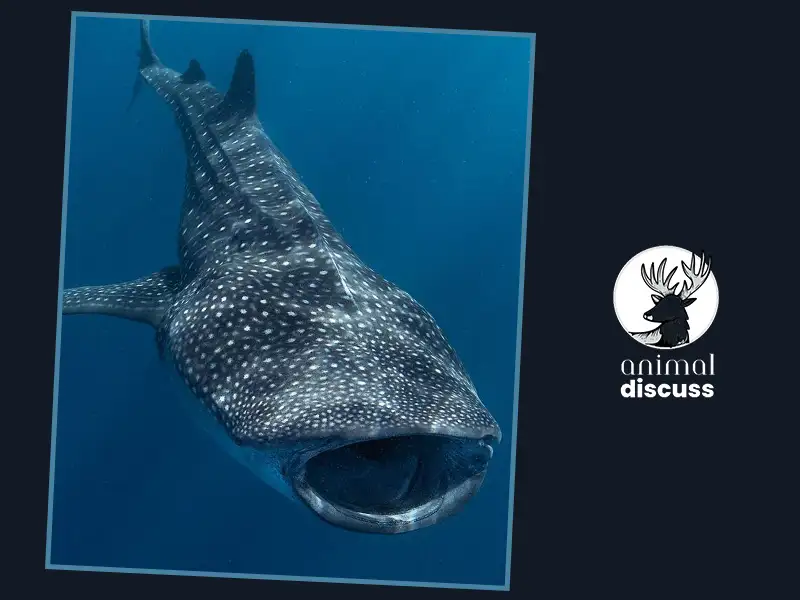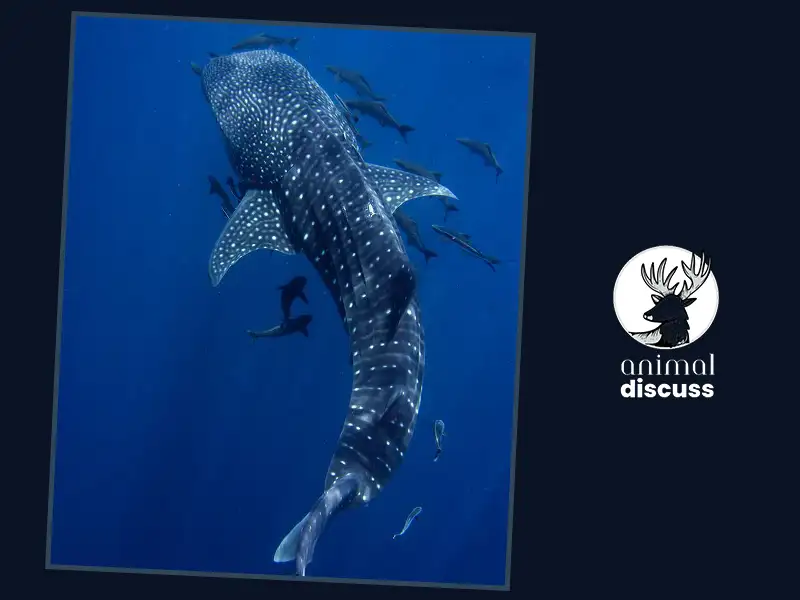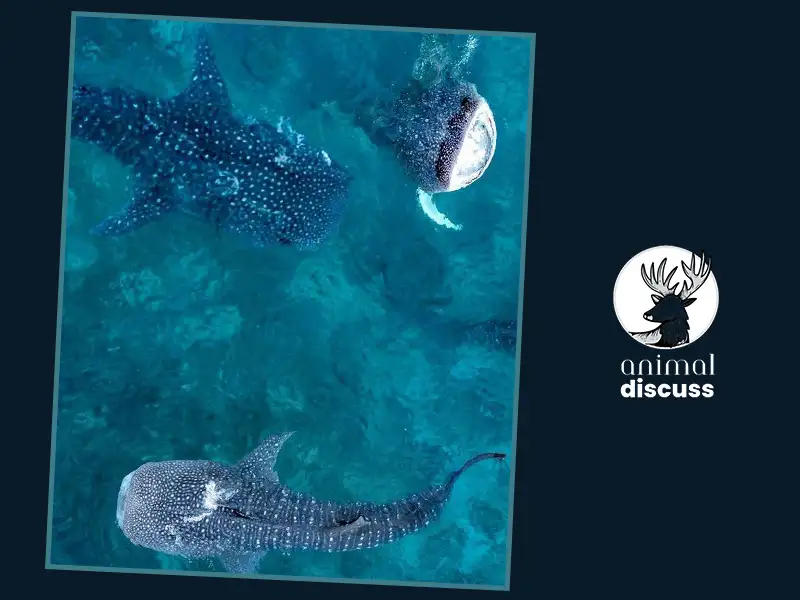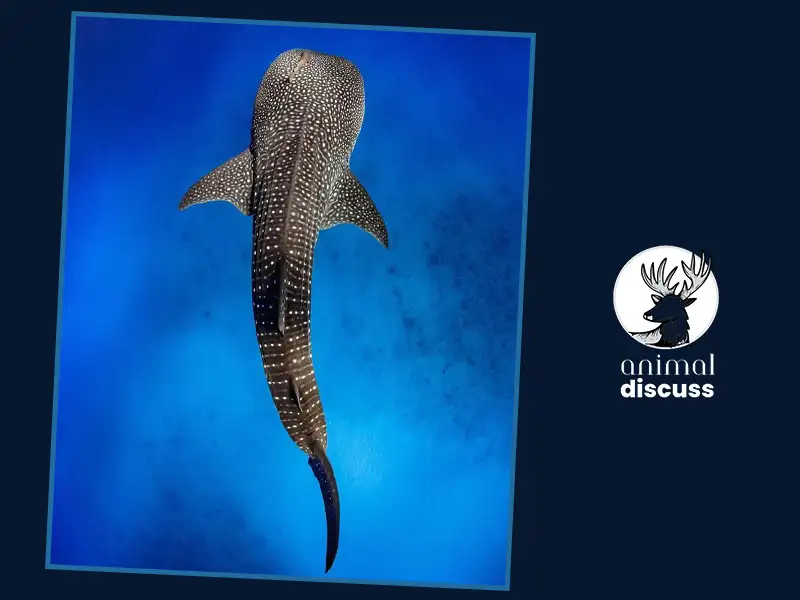Whale Sharks are known as gentle giants. But one question is why are they called gentle giants? They are named due to their astonishing length and size that mesmerized people and they are known as the king of the ocean.
Moreover, they have a wide mouth to eat a huge range of fish and water. Also, their gill structure helps them to extract oxygen from water and the most interesting fact is their fingerprints.
In this blog, I will dive into the interesting world of whale sharks and explore their size, unique characteristics, feeding habits, behaviors, global distribution, and the threats they face. Stay tuned!
Characteristics of Whale Sharks: What Does It Look Like?
Whale Sharks’ lifespan is longer than other creatures in the sea. Their distinctive appearance sets them apart from other marine creatures. For instance
- A wide mouth
- A broad, flattened head
- On a dark gray or brownish background, they have pale yellow spots and stripes
- Each shark has individual marks like human fingerprints which make them unique
The below table shares a quick overview of this gentle giant:
| Features | Facts |
|---|---|
| Common name | Whale Shark |
| Scientific name | Rhincodon typus |
| Family | Rhincodontidae |
| Size | 16-32.8 feet |
| Weight | 20.6-25 tons |
| Average lifespan | 70 to 130 years |
| IUCN red listed | Endangered |
| Diet | Carnivore |
| Habitat | Tropical and warm temperate ocean |
| Average litter size | 12 |
| Coloration | Countershaded (blue-gray to gray-brown) |
| Top speed | 10 mph |
| Lifestyle | Solitary |
| Predators | 01. Adult: do not have natural predators 02. Younger: Orcas, blue marlin, blue sharks |
What Do Whale Sharks Eat?
Being filter feeders, whale sharks mostly consume plankton, which includes copepods, krill, and tiny fish. They use a special feeding mechanism to collect their minuscule prey.

However, they produce a vacuum by opening their mouths wide, which lets water pour in. After that, they hold the prey for ingestion while filtering the water through their gill plates.
It’s interesting to note that whale sharks occasionally show a preference for larger prey, such as squid and tiny coastal fish. Because of this, they are opportunistic feeders that can modify their diet in response to changing food sources.
To know more about Whale Sharks’ eating habits, have a look at “Whale Sharks Food and Diet”.
Whale Sharks Behavioral Fact
Whale Sharks’ behavior is also unique like their feeding pattern. Some key points of their behavioral facts are discussed below.
Breathing Pattern
Because whale sharks are known for their ram ventilators, they must continually swim in order to maintain an adequate oxygen intake.
They swim with their mouths open to allow oxygen-rich water to constantly pass through their gills, which helps them breathe effectively.

Whale sharks are able to flourish in a variety of oceanic environments because of their special breathing adaptation.
Social Interaction
Even with their enormous size, whale sharks have a kind and friendly personality. They frequently act comfortably with people and other marine animals.
The most common interaction time of whale sharks is feeding aggregation. Because in that time they gather in one place to have plankton where nutrient-rich water rises. Then they interact with each other while taking water to filter their food.
Moreover, when they travel thousands of kilometers or more than that, they swim in a loose group. That means they travel side by side.
Apart from this, whale sharks communicate through their body language, possibly vocalizations, visual cues, etc. Also, they may produce low-frequency sounds for communication with others.
Mating and Reproduction
Because of their elusiveness, whale shark mating and reproductive habits are still mostly unknown. The term “ovoviviparity” refers to the internal egg-carrying and live birthing process that female whale sharks engage in.
However, while there is still much to learn about whale shark mating behavior, social interactions are considered to be important throughout the breeding season.
Male whale sharks have a reputation for pursuing females and participating in courtship displays including parallel swimming and nuzzling.
These brief events, which are mostly centered on reproduction, also show a type of social activity between whale sharks of different sexes.
To know more about Whale Sharks’ eating habits, have a look at “Whale Sharks Behavior”.
Where Do Whale Sharks Live?
Whale Sharks basically live deep in the ocean. They are known as the largest sea creatures in the whole world.
The details and key information are given below.
Global distribution
Around the world, whale sharks live in warm, tropical, and temperate waters. Both offshore and coastal locations are home to them.

For instance, these magnificent animals are found in tropical and warm-temperate waters, usually living along coasts and offshore islands. Among other places, the Indo-Pacific, the Caribbean Sea, and the Gulf of Mexico are among those where they are frequently seen.
Also, the Philippines’ Donsol Bay, Australia’s Ningaloo Reef, and Mexico’s Isla Holbox are the most well-liked places to see these gentle giants.
Relationship with different oceanic environments
Whale sharks are remarkably adaptable when it comes to where they choose to live. They inhabit a variety of marine environments, such as open waters, estuaries, and coral reefs.
However, their existence in these varied habitats is indicative of their remarkable adaptability and ecological importance.
To know more about Whale Sharks’ habitat, have a look at “Full Article”.
Migratory Patterns of Whale Sharks
The migratory pattern of whale sharks is a unique and interesting aspect of their behavior. They can migrate a long way such as hundreds or thousands of kilometers. Also, their migration is connected with various factors.

Here’s a glimpse into the migratory patterns of whale sharks.
Long Distance Migrations
Whale sharks are known to travel great distances on long migrations. The fact that these migratory patterns have been seen in several locations to a worldwide phenomenon.
However, Sharks have been spotted traveling hundreds of kilometers over entire ocean basins in a single trip.
Furthermore, whale sharks are known to gather periodically in some areas. For instance, Australia’s Ningaloo Reef, in order to feed on plankton blooms.
Seasonal Aggregations
Whale sharks gather in particular areas in great numbers during particular seasons of the year. They migrate seasonally, possibly due to variations in the water’s temperature, the availability of food, or the habits of their breeding.
For example, they might travel to warmer waters in the cooler months, and to regions with plenty of food in the warmer months.
However, sites like the Gulf of California and the Galapagos Islands are well known for being the sites of these gatherings between May and September.
Threats and Conservation Concerns of Whale Sharks
Whale Sharks are crucial to marine ecosystems and face so many threats from different points of view.

Thus, the most threatening factors are humans and their irresponsible behavior such as environmental pollution, overfishing, collision with vessels, etc.
Let’s discuss them shortly.
Pollution and Climate Change
Whale sharks are seriously threatened by pollution, which includes plastic trash and chemical discharge. In addition, the availability of their main food supplies, like plankton, is impacted by climate change, which also disturbs their natural habitats.
Overfishing and Bycatch
Unintentionally entangled in fishing nets intended for other species, whale sharks are frequently the victims of bycatch. Whale sharks may find fewer food sources available to them if their prey species is overfished.
Collisions with Vessels
There is a greater chance of unintentional collisions with whale sharks as boat traffic grows. Their populations may be further endangered by these collisions, which may result in injuries or fatalities.
Conservation Concerns of Whale Sharks
With the aim to protect whale sharks, the International Union for Conservation of Nature (IUCN) plays a vital role in recognizing and reducing the risks. The IUCN Red List of Threatened Species presently lists whale sharks as “Endangered.”
This designation indicates that, without the implementation of suitable conservation measures, there is a significant risk of the species’ destruction in the wild in the near future.
In that regard, a few key conservation concerns are mentioned below:
- It is essential to implement and enforce rules that forbid the hunting, trading, and harassment of whale sharks.
- Whale shark accidents can be reduced by putting bycatch reduction measures into place. For instance, using different fishing gear and methods and creating marine protected areas with fishing restrictions.
- Long-term conservation of whale shark populations can be achieved. For example, by reducing the release of greenhouse gases and protecting vital habitats in order to minimize the effects of climate change.
Frequently Asked Questions
Let’s have a look at some mostly asked questions about whale sharks.
01. Are Whale Sharks Dangerous to Humans?
No, whale sharks are not dangerous to humans. Because they are friendly in nature.
02. How do scientists track whale sharks?
Researchers follow whale sharks using a variety of techniques, such as photo identification, acoustic tracking, and satellite tagging. These techniques help in the comprehension of population growth, behavior, and mobility by researchers.
Conclusion
As the gentle giants of the water, whale sharks amaze us with their enormous size, distinctive features, and calm nature. But because of all of the dangers that human activity poses to them, there is an urgent need for international conservation initiatives.
Whale sharks are unique among fish because they can come to the surface of the water. Through the integration of scientific inquiry, global cooperation, and public education, we can guarantee the continued existence of these amazing animals.
References
- https://www.aquariumofpacific.org/onlinelearningcenter/species/whale_shark
- https://www.wwf.org.uk/learn/fascinating-facts/whale-sharks
- https://www.floridamuseum.ufl.edu/discover-fish/species-profiles/rhincodon-typus/
- https://www.iucnredlist.org/species/19488/2365291
- https://www.barrierreef.org/the-reef/animals/whale-shark
- https://www.cms.int/sites/default/files/publication/Whale%20Shark.pdf
- https://marinemegafauna.org/whale-sharks/facts

